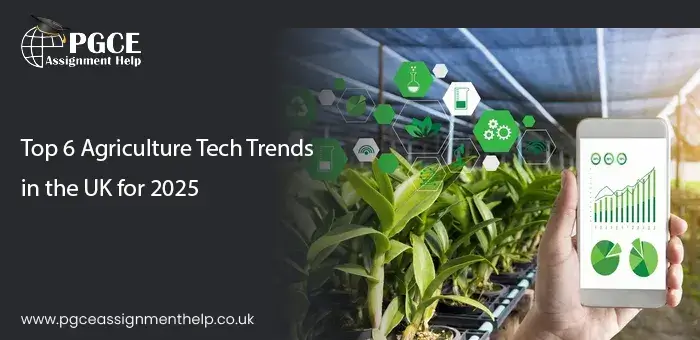“Agri-tech is not just about robots and data — it’s about real solutions for real farmers, helping to deliver food security and environmental sustainability.” —Dr. Belinda Clarke (Director, Agri-TechE).
In 2025, new agricultural technology is making a difference. Considering the increase in the growing population, it is expected to hit 9.7 billion by 2050. Thus, Agri-tech is the right solution to cater to this issue.
Agri-tech includes a wide range of technologies, including biotechnology, software, robotics, information monitoring, data analysis, and others. In addition, the implementation of such tech can help in improving efficiency, reducing capital, and increasing yield.
Imagine using IoT devices to maintain the perfect checks and balances on your crops, AI to create a schedule for watering, and autonomous machinery to handle labor.
Well, there is so much more to know about the Agri-tech and how it’s transforming to make a change!
Exciting Trends in the Agri-Tech
Agricultural Robotics
Labor shortage or having less skilled men has been a great problem over time. But not anymore because now, AI robots have got your back. Moreover, these robots can perform all the tasks that a farmer does.
“It’s not just about inventing new technologies; it’s about designing them so they fit the real-world needs of farmers.” –Dr David Rose (University of Reading, specialist in agricultural innovation).
These machines can pick fruit, plant, transplant, harvest, seed, spray, and weed. In addition to that, a good example of it is the automatic or semi-automatic tractors, which can easily harvest and navigate.
PGCE assignments are also related to agricultural education. Thus, they need to understand how robotics works in real farming. Also, it provides good real-world examples to support their work.
Fact Check
At the end of 2023, it was announced that more than 19 projects would be working to create automation tech. For that, it would get a share of £12.5m through the Farming Futures Automation and Robotics competition. (Source Price Bailey).
AI and ML Drones
AI (Artificial Intelligence) and ML (Machine Learning) drones are bringing big changes to farming. These smart drones can fly over fields and collect important information about crops. Moreover, they help farmers find problems like dry soil, pests, or diseases early.
The drones use AI and ML to study the data and give quick advice on what actions to take. In addition, this aids farmers in saving time, water, and money. They can also spray fertilizers or pesticides exactly where needed, instead of the whole field. Hence, by using these drones, farmers can grow healthier crops and get better harvests.
Have you heard of vertical farming? The indoor method of stacked planting? If not, read the section below to learn more about it.
Vertical Farming
Let’s get out of the traditional farming and agriculture style and step into vertical farming. Okay, but what is it?
It’s a method of growing crops indoors that are often in stacked layers. In addition, it uses controlled space and soilless techniques.
Moreover, in this process, the plants’ roots can be reused easily up to 30 times, and also reduce water usage by 95%. Also, do you know that it can eliminate the pesticides and ensure safe farming? Yes, that’s true. Its aim is to maximize food production in a limited area.
Noteworthy point:
Vertical farming can yield higher crops than traditional agriculture. Hence, it also potentially reaches 1300% higher yields in some cases.
Precision agriculture
Let’s picture this: you have a field of hundreds of acres of land and countless crops are harvested there, how would you look after them?
Will you have to keep an eye and, check and balance on each of them all by yourself? Does that sound like a great idea? Well, I don’t think so.
This is when precision agriculture comes in. It uses various tech, including GPS, sensors, automated steering, and remote sensing. Also, the agricultural field differs in terms of soil properties, exposure to sunlight, and slopes is now outdated.
By applying resources only where and when needed, it reduces waste and minimizes environmental impact (Source Meteobot).
Agricultural Biotechnology
Agricultural biotechnology is a scientific method to improve the quality of crops via a range of tools. In addition to that, these include traditional breeding to improve the quality of plants.
Moreover, it aims to increase food production and reduce the need for pesticides. In addition, it increases yield and makes a difference in the industry.
Modern applications include developing crops with herbicide tolerance, insect resistance, and improved nutritional profiles. Not only this, but also it improves livestock breeding and disease resistance.
Pupils seeking help with PGCE assignments can explore this field for real-world applications in sustainable farming practices.
Final Words
Agri-tech is no longer a future dream — it’s happening now and making farming smarter, faster, and more sustainable. With trends like robotics, AI drones, vertical farming, biotechnology, precision farming, and smart irrigation, the future of agriculture in the UK looks bright.
Farmers are getting better tools to feed the world while protecting our planet. As the population grows, these technologies are not just helpful; they are necessary for ensuring food security and environmental care. The journey of Agri-tech has just begun, and it’s already making an incredible difference!
